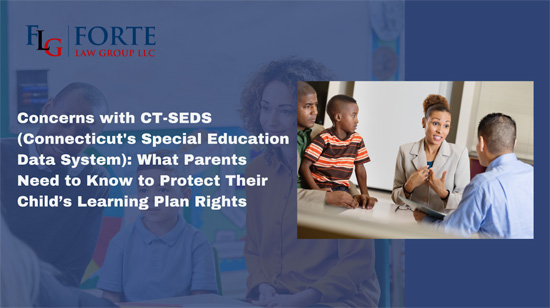
As a parent of a child with disabilities, navigating the Connecticut Special Education Data System (CT-SEDS) can be overwhelming. CT-SEDS is the state’s online platform for managing Individualized Education Programs (IEPs) and special education records. It was designed to streamline documentation and ensure compliance with federal and state special education laws. However, many parents and educators have raised concerns about its functionality and how it impacts their ability to advocate for students effectively.
Understanding these concerns is crucial to ensuring your child receives the support they need. Here’s what you need to know:
1. PPT Summaries Are Optional – Parents Must Request Them
Previously, a summary of the Planning and Placement Team (PPT) meeting was included in IEP documents, providing an important record of key discussions and decisions. However, in CT-SEDS, this is now optional and not automatically included. Without a designated section for the summary, it is less likely that one will be written. Parents must actively request a summary if they want a written record of what was discussed and decided.
2. Goals and Objectives Lack Organization and Clarity
- Goals and objectives are not numbered in order, making it difficult to track progress.
- Objectives themselves also lack numbering, which previously helped parents and educators reference specific areas (e.g., Goal 1, Objective 3).
- The system does not clearly define evaluation procedures or performance criteria for measuring progress, making it harder to hold schools accountable. Parents should ask for specific evaluation methods and progress monitoring details.
3. Transition Goals and Assessments Are Inconsistent
- Transition goals, which help prepare students for life after school, are not consistently numbered, making it harder to track progress.
- The system does not allow older transition assessments (conducted more than a year ago) to be entered, leading to a loss of historical data that could be important for long-term planning.
4. Parents’ and Students’ Input Can Get Lost
While there are sections for parent and student input, they often become diluted within other academic and functional performance sections. Additionally:
- There is no dedicated place for parents to list their general concerns.
- There is no clear section for parent and student input on transition services, which is critical for post-school planning.
5. IEP Progress Reports Don’t Align with Goals and Objectives
Parents rely on IEP progress reports to track their child’s development, but in CT-SEDS, these reports do not always align with the numbering of goals and objectives. This misalignment makes it difficult to understand whether a child is truly progressing toward their goals.
6. Prior Written Notice (PWN) Lacks Clarity
Prior Written Notice (PWN) is a legally required document that informs parents about changes to their child’s IEP. In CT-SEDS:
- The PWN is often too general (e.g., stating “IEP revised” without details).
- The separate issuance of PWN from the IEP document may result in parents not receiving clear, detailed explanations of proposed changes or rejected requests.
7. Issues with Paraprofessional Support
CT-SEDS only allows two options for paraprofessional support: 1:1 (one para per student) or 2:1 (two students per para). Some school districts mistakenly interpret 2:1 as two teachers for one student, which can lead to confusion. Parents should clarify their child’s needs in meetings.
8. IEP Amendments Require Parent Signature Before Viewing Changes
If a school wants to amend an IEP, parents must sign an authorization before seeing the changes. This is a major concern because parents should always review and understand amendments before agreeing to them.
9. Present Levels of Performance Are Limited
- The option to mark domains (such as communication, motor skills, etc.) as “age appropriate” is missing.
- Certain areas (e.g., fine and gross motor skills) are not included, potentially overlooking key aspects of a child’s needs.
- Parents should advocate for a full discussion on all relevant performance areas during PPT meetings.
10. The Parent Portal Is Difficult to Access
Many parents report difficulty accessing the CT-SEDS parent portal or are unaware that a portal exists. The Connecticut State Department of Education (CSDE) should implement a dedicated helpline to assist parents in accessing their child’s special education records.
11. Technical Issues with Page Numbering and Document Sharing
- Page numbers are a strength in CT-SEDS, but school staff cannot see them until the document is downloaded as a PDF, making real-time discussions harder.
- Some school districts claim they cannot share the draft accommodations page with parents before a PPT meeting, which limits parents’ ability to review and prepare.
12. Customization Options Are Unclear
Parents may wonder whether they can customize progress monitoring (e.g., changing check-ins from quarterly to weekly). Clarification is needed on whether custom fields can be added within CT-SEDS.
13. Alignment with CT’s Common Core Standards
There is no clear update on when IEP goals and objectives will align with Connecticut’s Common Core Standards in CT-SEDS. This alignment is essential for ensuring students are meeting appropriate academic benchmarks.
14. Confusion About Transfer of Rights at Age 18
- CT-SEDS includes a section about whether IDEA rights transfer to the student at age 18.
- Some schools incorrectly tell parents that they must obtain guardianship for their child to continue participating in PPT meetings. However, a Power of Attorney (POA) can often suffice, and parents should be informed of this option.
What Can Parents Do?
Given these concerns, parents should take proactive steps to ensure their child’s needs are met:
- Request a PPT Summary after each meeting.
- Ask for numbered goals and objectives to ensure clarity in progress reports.
- Demand clear evaluation criteria for measuring progress.
- Ensure transition plans are complete and up to date.
- Make sure your input is included in the IEP and not lost in the document.
- Clarify paraprofessional support options to ensure your child receives appropriate assistance.
- Review any IEP amendments before signing.
- Access the parent portal and report issues to the school district.
- Ask about Power of Attorney options instead of assuming guardianship is required at age 18.
If you encounter difficulties with CT-SEDS or feel your child’s rights are being compromised, seeking legal guidance can help you navigate these challenges effectively.
At Forte Law Group, we are dedicated to empowering parents and protecting the educational rights of children with disabilities. If you need help advocating for your child’s IEP or have concerns about CT-SEDS, contact us today for a consultation.
Visit our website to know more about Forte Law Group and how we can support you through your challenges.
Schedule a consultation call so we can fully answer your questions, check available dates here



